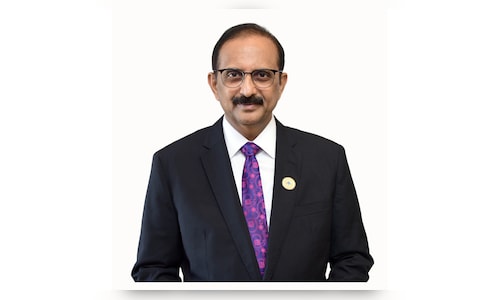
Speaking to CNBC-TV18’s Shereen Bhan at the 11th edition of SBI Banking & Economics Conclave, Ananya Birla of Svatantra Microfinance; Nyrika Holkar of Godrej & Boyce; Anant Goenka of RPG Group; Sagar Adani of Adani Green Energy; Jinal Mehta of Torrent Power; and Chairman of SBI CS Setty; shared their views on inclusivity, gender parity, and adapting to a rapidly changing economic landscape.
Below are the excerpts of the discussion.
Q: Let me pick up on some of the challenges. The FM laid out the challenge as far as deposit mobilisation is concerned. Now, is this a structural change that we’re seeing? Is this a structural shift that we’re seeing, that more and more people are looking at other avenues of putting their money to use, as opposed to bank deposits? What kind of challenge does that throw up for banks like yourself, as you look at the next decade, and to 2047? Do you see this as a structural shift? How do you combat it?
Setty: There is a structural shift. I think it’s also a sign of a maturing investment climate and digitalisation, which has played an important role. I was just sharing with someone, if somebody earns ₹1 lakh salary, ₹50,000 he spends. A few years ago, he was not bothered about putting this ₹50,000 in either an investment or even a fixed deposit in the bank because going to the bank and filling up a form; it was too much of a pain. And even SIP was not an easy task. But today, with two clicks, he can move these funds out of a savings bank into a fixed deposit or SIP. This means that the ease of doing business is also resulting in a structural shift, apart from the opportunities for investment.
But having said that, I strongly believe that it is also a fact that in the last decade, the banks have not been focusing on deposits. In fact, during COVID, a lot of banks did not want the deposits. The only bank which was taking the deposits was SBI.
So a banker magazine called that one generation of bankers have forgotten to ask for deposits. So probably it’s coming back, and I’m sure it will, and it is effort elastic. I’m sure that as the income levels of individual goes there’s an asset allocation, and I hope and trust that the bank deposits will be one of the important asset which they will definitely consider, apart from the SIP.
Q: SBI has got a legacy of 100 years. As you look at the future, as you look at where growth is going to come from in the years to come, how do you stay an old but yet a young bank?
Setty: I’m relatively older when you compare to the generation sitting in the panel, but I represent a 218-year young bank. We always re-imagined ourselves, tried to stay relevant. I think that is where, probably I found a place in the panel here.
In terms of the aspirations of Viksit Bharat, and how do we move towards that? If you see these young leaders who are here, each of them have very clear ideas about some of these elements which go towards realising this aspiration of Viksit Bharat, whether it could be financial inclusion, what Ananya is involved in, our green energy initiatives what Sagar and Jinal are working on. And if you think about Anant, I think he has done many things, and he continues to do many things. I think this gives me confidence that we are moving in the right direction.
We believe as being the largest bank in the country, being a proxy to the Indian economy, we see from very close quarters that there are two elements that are very, very important to achieve this aspiration.
I think inclusivity is very critical. I think you can’t leave a large population behind when you are progressing in the country. How do you take them along? It may not be in the same pace as the advanced companies—the people with technological prowess move, but we have to take them along. And one of the critical pieces is the credit.
And this moving from opening a bank account to making the other elements of financial inclusion available to them is going to the critical piece. I think all these young leaders have to play along with the banks like SBI.
The second feature is innovation, which is again linked to inclusivity in the sense that, how do we bring products, processes and the technology which will make this inclusivity much more seamless. That, again, quite a lot of work is being done by these leaders who are sitting here, and this gives me confidence that we are moving the right direction both in terms of being the third largest economy and a developed country by 2047 and increasing the per capita income of the households.
Q: I want to start by asking you what we have traditionally seen in business families, really large conglomerates, where the women are not made custodians of the brand, are not made custodians of the group. They’re not even part of the shareholding necessarily. What was that conversation like between you and your dad when the decision was made that you are going to be a part of the business?
Birla: I feel very grateful that I didn’t have to really have that sort of a conversation with my father. I think he’s just very forward-thinking. I started Svatantra Microfinance at the age of 17, and he always saw my passion for business, and he saw me working hard on my skills. So I think it was something that just naturally happened.
Having said that, there are small things that we always talk about, the holding company is Birla Sons. I say, it should be Birla Sons & Daughters.
Q: Is that likely to happen soon?
Birla: I just had a conversation with my grandmom. I said, you’re the head of the family, and being a strong, empowered woman yourself, please make this change.
Q: Is it up for consideration?
Birla: 100% up for consideration. I don’t want to make any guarantees, but hopefully that’s a change that we can make. So small things like that that actually aren’t small at all.
But, things like this matter to me, being a woman. Another example is, being on the board of Hindalco and Grasim. We have two women or three women maximum, on a board of approximately 15. So I was having a conversation like that with my father, and he’s very aware, he’s not ignorant about the fact. He’s very aware that, as a group and as an organisation, we need to have more women come on board. He’s very aware of what women bring to the table. He’s very aware of the importance of equality. And these are things that we are working on. It’s a large organization. I am the seventh generation, and he’s the sixth. So, of course, there’s a lot of baggage that comes and he needs to work through all of that as well.
I’m doing my bit, at Svatantra Microfinance, it’s completely 50-50, I think men and women add equal value. I think having an organisation with too many women has its own issues. So I truly believe in equality.
Q: Your joining the family business was not a question of if, but it was a question of when, and now, as you transition into taking the legacy of this group forward, but like Ananya said, also looking at how you ensure that it stays relevant for the future, what are you prioritising?
Holkar: Touching upon the point that you mentioned earlier in terms of women and women’s participation. I think today, maybe in our family, it was of necessity. So the conversation maybe came about in a different way. But I don’t think there was a hesitation or a reticence. But at the same time, if we have to reflect on the progress of the group today, I remember my grandfather was very progressive in views on everything, but he didn’t want women to be part of the business. So I think that has evolved. And I think in India we’re seeing a lot of that changing. But I think there are so many India’s in India.
There are many parts of India where this is not a reality. So I think that it’s our responsibility to ensure that we are doing more to be able to bring more women into the ecosystem because if one woman is empowered, her whole family is empowered, and I think that’s very important.
Q: So are you setting targets on what you’d like that to be in terms of parity?
Holkar: I have to admit that the parity is quite poor, and I think it’s also from a very engineering mindset, moving into a more customer centric mindset- the question has always been, there are not many women in engineering, and so that’s been kind of a reason for the diversity ratios. But there is a strong emphasis on it today, in terms of two of our factories, our oldest factory – locks factory, and also in appliances, they’re all women. Also in advanced engineering and design, many more women taking the roles, which earlier was more HR related roles. So we are seeing that progress. Is it as fast as we wanted to be? Probably not, but it’s happening, and we need to have the structures in place to be able to support that, because it doesn’t just happen.
Watch the video for more



